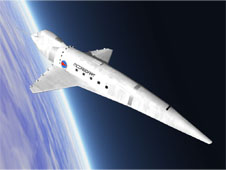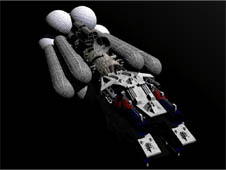Space Technology
As distances vanish and the people can flow freely from place to
place, society will cross a psychological specific heat boundary and
enter into a new state. No longer a solid or liquid, we have become
as a vapor and will expand to fill all available space. And like a gas,
we shall not be easily contained.
- Sister Miriam Godwinson, (Sid Meier's Alpha Centauri)
Orbital habitats were just becoming useful in the solar system as the colony ships left, and the technology has been developed anew on Nova, New America and Arcadia. Building a habitat large enough to sustain a working ecosystem is not easy, but once it has been done it is fairly simple to maintain. Most habitats are spheres or cylinders, with rotation generating pseudogravity and either fusion light or light from mirrors entering the interior to provide sunlight. Typical sizes are one kilometre and upwards; the largest so far is the Glenn of New America, 7 kilometres long. There is much talk about antigravitation-based habitats, but no firm designs yet.
The leaders in the field of habitat construction is clearly the technorats of New America. Unity is however catching up quickly, and the Arcadian ecodesigns are unique. The competition is increasing.
Starships
Starships
are huge, expensive constructions requiring advanced technology to fly
and maintain. A common design consists of a cylindrical core containing
the higgsram and banks of fusion reactors to power it, a small crew compartment
and the quantum computers needed to control it. Traditional in-system
ships dock with the core (often called just "the engine") and
are carried along with it as it jumps.
The old colonisation ships used ice as reaction mass; fusion reactors vaporised it to provide thrust, and the ice supply was placed in front and around the ship as a radiation shield against relativistic micro-collisions. Usually the core of the ship held the cryosystems for the colonists and their biological stores, life support and central control systems. Outside the core were cargo bays, living space, workshops and laboratories. In-system exploration craft and shuttles were placed towards the stern where the thruster systems were located.
Water is important in space as a propellant; it is heated by fusion into steam and expelled through nozzles. In many systems the water fuelling stations have become the major trade centres. In Nova the Unity bases around Zeus and Nova itself are the major sources of revenue for the borganisms, and the NASA orbital around New America is the seat of power for the technorat fraction.
Starship Production
Nova has two major space-engineering firms, Unity Starships and the Hertz-Kaneda Group. Nova designs tend to be dramatic; while Unity itself likes understatement its customers want style. The current Nova fleet involves the early exploration ships Democracy, Freedom and the Unity built Networker. Later ships involve the Barto (owned by Graunstein Interstellar), the Vulkan (jointly owned by HedTronics, Universe Travels and Pan Space Systems, used for Nova-Dionysos travel) and the Faithful (Tyrus Interstellar). Unity has also constructed Tractor, an utility starship intended to move space habitats (it was first tested with the move of Origo to L145 141).
New America has a national space agency NASA building and manning most starships, but a private corporation, Durand-Maxwell Aerospace has begun to manufacture ships; the first private starship, the Lynx, was launched in 2349 and is operated by DM Trade. NA ships tend to be functional rather than aesthetic: modules and machinery bundled together in open frameworks. The NASA fleet involves the Ramirez and Edison (both obsolete), the Grossberg, Guth and Enterprise (in use) and a number of as-yet unnamed starships in the Columbus Program.
At Penglai the PCA operates the colonial starships. At present only three have been built. Penglaise ships employ clever tensegrities and modules that can be unfolded almost like origami; they are highly adaptable, able to withdraw into armoured eggs or unfolded into thin networks.
Arcadia has a major space facility, operated by an offshoot of the Space Life Project, funded by most of the Hives. They operate several ships intended for trade, communication and exploration. The Arcadian ship style is the plain ovoid, but with a crammed inside of small irregular rooms and warrens. The current fleet involve the Pathfinder, Discover, Ahrenius, Darwin and Linneaus.
 Atlantis
has a major space industry, with several competing shipyards. The two
largest are McDaggart Transplanetary Shipyards, and Heinlein Networks
Inc, but they are a bit slower than the smaller shipyards like Spacedev
Enterprises and Firestar. Atlantean ships can look like anything from
tiger-striped warships to utilitarian boxes Ė regardless of their real
purpose. Currently much interests focus on the new Heinlein Bork series
of ships. Currently there are just four Atlantean ships: the Adam Smith
Trading Company (owned by the consortium of the same name), Bottom Line
(Rotha Netsys), Lady Koumakov (Aurum Investments) and Whatís For Lunch?
(the Whatís For Lunch Group), but many more are under construction.
Atlantis
has a major space industry, with several competing shipyards. The two
largest are McDaggart Transplanetary Shipyards, and Heinlein Networks
Inc, but they are a bit slower than the smaller shipyards like Spacedev
Enterprises and Firestar. Atlantean ships can look like anything from
tiger-striped warships to utilitarian boxes Ė regardless of their real
purpose. Currently much interests focus on the new Heinlein Bork series
of ships. Currently there are just four Atlantean ships: the Adam Smith
Trading Company (owned by the consortium of the same name), Bottom Line
(Rotha Netsys), Lady Koumakov (Aurum Investments) and Whatís For Lunch?
(the Whatís For Lunch Group), but many more are under construction.
Traha has so far not built any ships on its own, but the empire is planning to buy a ship soon; a major competition for the order is developing.
Dionysos has no ships on its own, but Pan Space Systems is collaborating with the Nova corporations HedTronics and Universe Travels to set up a spaceline.
Ridgewell, Pi3, Gaia and Mary all lack starships or do not desire them.
At present, given the few ships (all in all just a dozen in 2350) and the long travel times contact is just beginning.
FTL
We move because we hate the idea of standing still.
We create because we want something new in our life.
We take the next step because we want to rise above.
This is our mission, this is our passion.
- Daewoo Corporation
Modern ships use higgsram technology for interstellar travel, while in-system travel is done using the tried and tested water thrusters, fusion torches or the Mothersí reaction drives. The Higgsram is an advanced application of quantum mechanics and Higgs field manipulation; while the theory is well understood these days the actual construction is still regarded as pretty arcane. Improving on the filigree design is tricky.
The basic idea is to create an intense localised Higgs field to cause local inflation of a single quantum wormhole; the wormhole expands enough to let the ship slip through, and then collapses behind it. The actual diving is done completely using quantum computers and AI, but the pilots direct their work and heuristically orders what kind of wormholes to look for.
The ram field is based on advanced filigree technology, a kind of soliton wave in front of the ship able to act both to "feel out" the space-time foam, and to focus the charged energy onto a single small region. Matter entering the ram is immediately confused, and can be quite dangerous (an important reason jumps are usually done far from the ecliptic). The ram is often visible as a cone of light, as stray particles and neutrinos are confused. The energies involved are very large, and usually a ship takes several hours or even days to charge the ram before doing the jump. Skilled pilots/Quais can retain energy in the ram through the dive, but normally a recharge is needed afterwards.
To an outside, the dive looks impressive: in front of the ship a space-time distortion explodes outwards, only to collapse onto itself as the ship vanishes into it. Einstein rings and gravitational lenses appear, diffracting and reflecting the light from stars behind the wormhole and the blaze of the higgsram into strange patterns. The remaining gravitational ripples can be quite severe, and most ships try to jump in empty space to avoid cumbersome back-reactions (having a major mass near the wormhole is bound to disrupt the process - likely destroying the ship). From the inside the jump is brief and unsettling. Tidal forces from the wormhole tug at everything, making many humans spacesick.
Travel times depend on the skill and luck of the pilot/Quais as well as how quickly the field can be recharged. A normal speed is up to ten jumps a day, each jump ranging between 0.01-0.2 light-years. The direction of the jumps is a bit random; it is often joked that FTL is a foxtrot dance: two steps forward and one back.
Higgsram diving is as much an art as a science. The actual dive is done by quantum computer AIs, known as Quais. The pilots are mostly overseeing the dive, but thanks to Nova interface technology they have become able to take part of the dive. This isnít because human intuition is needed (as some technomystics claim) but because the dive process needs to make decisions based on the values of the human at a superhuman speed. The solution is to let the Quais read and interpret the pilotís mind, and find the wormhole link most like what he or she would have chosen, but augmented by the Quai intellect too. After enough dives together pilots and Quais become used to each other, and the interface become unnecessary.
Ship Systems
Higgsram
The higgsram system is generally built together with power units such as fusion reactors. The energy demands are staggering, and it is easier to use the overhead to power the rest of the ship than the reverse. The most conspicuous part is the huge higgsmodulators, long pillars of stacked uranium disks surrounded by dense induction coils and ending in the true higgsram at the front, where a complex field produces a stable focusable ram of concentrated energy able to induce local inflation of the quantum foam. The ram field can be several kilometres long. Once the wormhole is inflated the ship moves through quickly. In general the wormholes are blown up to a size of a few kilometres; this induces a tidal field of several g during passage, and small wormholes can be quite dangerous. If something collides with the ram field the object is disintegrated. The resulting explosion depends on the charge in the field and the size of the object, as well as how far away the detonation is. In general, masses of one gram and above cause damage to the ship.
The higgsram can totally store up to around 100 points of energy; each hour of charging increases it with 10 points. Opening a wormhole requires 10 points of energy per kilometre radius. The tidal forces scale as 1000/(radius 3) Newton; below 5 kilometres the ship or crew is likely to be damaged.
A normal human higgsram costs around 10M, takes 30 durability points and produces 30 power points if completely diverted for other uses.
Quai
While the higgsram contains the necessary quantum systems to sense and operate the ram, a quai is necessary to navigate the quantum foam well. It consists of a quantum computer module linked to the higgsram and the pilot (if any), running a special purpose AI program able to visualise and navigate quantum manifolds. As a jump is initiated, the quai shifts into a superposed state, links to the pilot and the pilot/quai entity uses the higgsram to probe the local foam to find a suitable wormhole. If it succeeds (a chance depending on the distance sought) the higgsram is released, and the wormhole is opened. Some ships are equipped with a special pilot-quai, a broadband neural interface that enables the quai to access the brain of the pilot and place it in a resonance state too so that it can interact with the quai in operation.
The distance the quai can jump depends on how good it and the pilot are at finding suitable wormholes. This is an arcane skill, possessed only by higgspilots and quais. Doing a jump requires a Quantum Navigation skill check, usually with the pilot assisting the quai. The difficulty depends on how well specified the destination is: random walk +0 (ship jumps apparently randomly, increase distance needed to travel by 100% at least), moving in the right direction +1 (the distance needed to travel is increased by 50% due to side-jumps), moving towards the target +2 (no change in distance), jumping to the target +4 (if within one light-year) +5 or more if more distant.
Critical Failure: misjump, the ship might end up anywhere. A second quantum navigation roll can abort the jump; otherwise the ship can end up anywhere within ten light-years at least.
Ordinary success: one tenth light-year jump.
Good: one light-year.
Amazing: ten light-years.
An Ordinary quai costs 1M, a Good quai 10M and an Amazing quai around 100M (so far none have ever been built).
Gravity Wave Detector
Wormhole opening and closing causes a noticeable "splash", and it can be detected by a gravity wave detector. The detector consists of a chamber filled with a gravitomagnetic field, reacting to disturbances in space-time. The range depends on the size of the wormhole and the distance; the difficulty to detect it (with System Operations-sensors) increases with +1 for every 10 AU and is decreased by Ė1 for each kilometre radius of the wormhole. Most colonies have large detector arrays to detect incoming ships; it is nearly impossible to sneak into a system with a higgsram.
Price: 100K
Gravity Assisted Takeoff and Acceleration (GATA)
 By
projecting an antigravity field around the ship, it can be made to mass
very little or actually fall upwards, providing an elegant way of takeoff.
Unfortunately the energy demands are similar to planetary thrusters, but
the ship does not need to have any reaction mass or streamlining (even
if the later usually is desirable). During takeoff the local gravity field
also affects the interior of the ship, creating unexpected complications
for the passengers (for example, falling away from a planet produces weightlessness
or a small negative gravity due to air drag). In space it can also be
used to produce acceleration, with the same benefits and drawbacks.
By
projecting an antigravity field around the ship, it can be made to mass
very little or actually fall upwards, providing an elegant way of takeoff.
Unfortunately the energy demands are similar to planetary thrusters, but
the ship does not need to have any reaction mass or streamlining (even
if the later usually is desirable). During takeoff the local gravity field
also affects the interior of the ship, creating unexpected complications
for the passengers (for example, falling away from a planet produces weightlessness
or a small negative gravity due to air drag). In space it can also be
used to produce acceleration, with the same benefits and drawbacks.
This largely replaces the Induction Engine of Alternity. Cost: 2 M Dur: 2 Pow: 2 per movement point generated; in an atmosphere 1 per 20 durability points.
Brilliant pebbles
An old idea that the Penglaiese have developed. Small devices that can accelerate to extreme velocity and act as either a weapon against missiles or other ships, or as distractors to confuse enemy attacks. They are controlled by evolving battle programs, gradually adapting to enemy tactics. Each cloud of pebbles can act either as a moveable cloud of chaff, attack incoming missiles or home in on enemy ships hitting it with great force.
[ Acc: -1 Range: 10/20/30 Type: Hi(p) Damage: d6+2s/d6+2w/d6+4w Actions: 1 After each hit, increase difficulties with +1 for all following uses (cumulative) due to the decreased number of pebbles in the cloud.]
